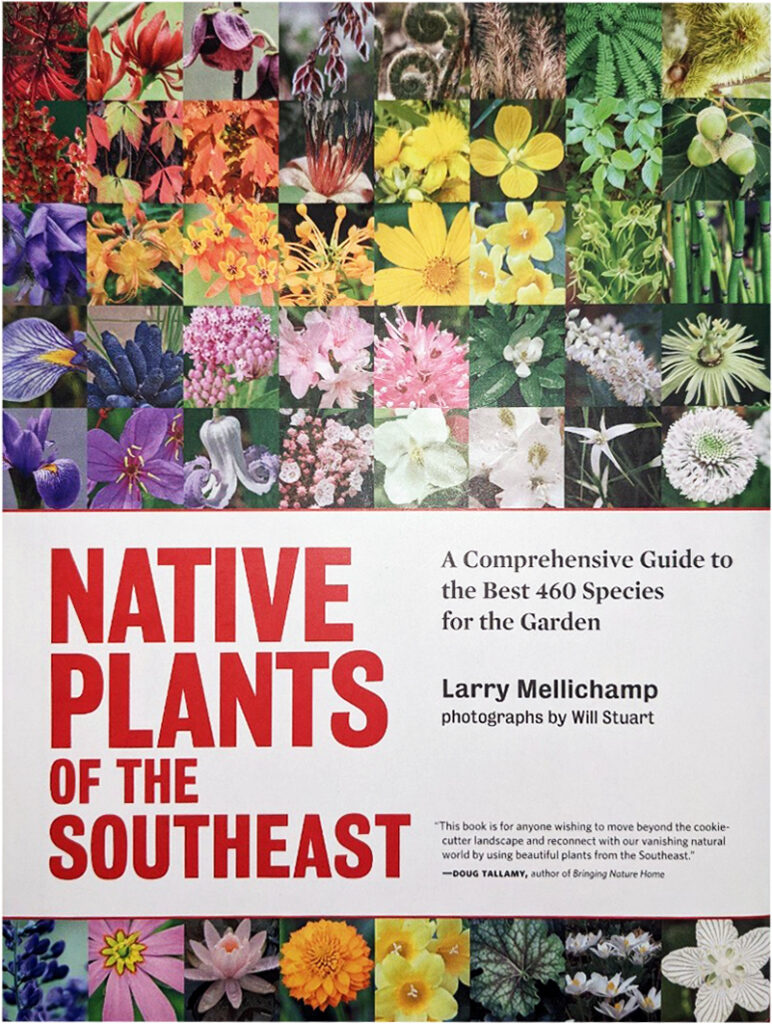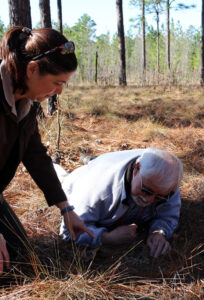By Will Stuart
I recently visited the Croatan National Forest for the first time. As I explored a rutted sideroad I found a cluster of tall, yellow asters at peak bloom. They were Wetland Sunflowers (Helianthus heterophyllus), tall and handsome with a single large flower head on a slender, nearly leafless stalk. Wetland Sunflowers are not common outside of the Croatan.
In recent years I would joyfully share similar “discoveries” with Larry. Invariably Larry would know the species, ask pointed questions, often have a story to share. He would delight in knowing parts of the Croatan are now well managed for such coastal wet pine species. I will miss sharing my native plant adventures with Larry.
He Inspired Us to Be Native Plant Advocates
In 2009 I was fortunate to be one of the early enrollees in the Certificate in Native Plant Studies at the University of North Carolina Charlotte Botanical Gardens. Now in its second decade, this experiential program has educated, entertained, and inspired hundreds of adults in an ever-evolving curriculum of native plant topics.
Program graduates are part of Larry’s legacy. They view their home landscapes differently. They are Master Naturalists, Audubon Ambassadors, and native plant advocates. Larry taught many of the core classes for over a decade. His students enjoyed hours of time in the classroom, guided walks through the university gardens, even a “Fern Foray” to the Pisgah Forest ending with dinner at the Mount Pisgah Inn.
Always With a Sparkle In His Eye
Successful teaching, like successful gardening, is part science and part art. Larry was a master teacher, uniquely able to frame and structure a lesson, always engaging his students while delivering sometimes complicated topics with enthusiasm and humor. Larry went far beyond identifying and describing native plants. His classes were filled with special moments when Larry, invariably with a sparkle in his eye, opened a door and invited students to enter the world of his plants. For a moment we were a fragrant blossom enticing a beetle, an aster offering a landing pad to a butterfly, a carnivorous plant luring a fly on its final, perilous journey.
For the first plant identification course Larry and Paula Gross constructed, from scratch, a scaled-down dichotomous key of local plants. They handed us freshly cut plants, one after another, each a lesson in the vocabulary of plant anatomy. From my class notes, I recall Larry drawing a stem and an attached leaf, then labeling the petiole, the node, and the axil. In my notes I have Larry’s admonition. “Always, always check the nodes!” he said. “Look for buds, glands, stipules.”
A Meticulous Scholar and Gifted Writer
In 2011 Larry asked me to provide photographs for Native Plants of the Southeast. For the next two years I would be a witness as the book evolved. Larry nudged Timber Press to add chapters on aquatics and bog plants.His writing reflected decades of experience collecting, growing, and purchasing native plants for the UNCC Charlotte Botanical Gardens. Larry had long-standing relationships with all the southeast native plant nurserymen and decades of involvement with the native plant community through the North Carolina Native Plant Society and the Cullowhee Native Plant Conference. He was a meticulous scholar and a gifted writer. I cannot imagine another author for this seminal publication on southeast native plants. You will find Larry’s scholarship and passion for native plants lyrically distilled into the few descriptive words Timber Press editors allocated for each plant.

As Larry and I worked to get photographs for the book, Larry would walk with me through Van Landingham Glen, stopping at plants, describing traits that made each special. He described the “Curlyheads” of Clematis ochroleuca, the distinctive bark of Spruce Pine, the rippling leaves of Seersucker Sedge. Along a garden walkway we stopped at a small, seemingly nondescript shrub. It was Leatherwood (Dirca palustris). Larry grasped a long, slender stem and tied a perfect little knot in the stem. He described the tiny flowers, the rounded tips of the leaves. As with so many species, Larry had a special appreciation for Leatherwood and his affection for the plant was contagious. In early March, 2011 I would use a macro lens to photograph a tiny pair of yellow blossoms and the frilly backlit margins of young leaves. You will find Dirca palustris on page 232 of the book. In Larry’s notes you will read “Dirca palustris is my favorite shrub. It is not showy, ever, but its charm will captivate you in subtle ways.” I can hear his words! I will let you read the rest.
I Heard a Very Loud Whoop!
I shared a few days in the field with Larry, each a special memory. On a trip to Steven’s Creek in South Carolina with Larry and Audrey, we became separated as I photographed Shooting Star. From a distance I heard a very loud “Whoop.” Larry had ventured off trail to get closer to a plant. He reappeared, unscathed.
When rare plants were in the offing, terrain and poor footing would not constrain Larry. On an early summer trip to Butner I was sure we would fall into a ravine while scrambling to get close to Stewartia ovata. In March of 2014 Lyne Askins, manager of the Carolina Sandhills National Wildlife Refuge offered to escort us to a known site for Little-leaf Pixie-moss (Pyxidanthera brevifolia). Lyne drove us to an otherwise nondescript longleaf tract where Larry and I followed as Lyne poked about in the pinestraw. Within a few minutes we had located a population of Pixie-moss in full bloom. Larry dropped to the ground, loupe in hand, and as he lay prone on the pinestraw, he examined the tiny blossoms, bubbled with enthusiasm, and gave us a lesson on the boxy anthers of this charming little shrub.
We would continue to an impenetrable streamhead where Larry would wade in and locate White Wicky (Kalmia cuneata), another rare sandhills endemic. It was a very good day of botanizing!
In 2016 Larry and I co-led an NCNPS fall field trip to the North Carolina Sandhills Game Lands. I had directed Larry to a special streamhead which is home to some of the best pocosin flora the sandhills has to offer. We had split into two groups, Larry and his group heading to the streamhead, my group hiking upslope to find Rhus michauxii. When our time to rendezvous had passed and Larry was still not in sight, I headed out to find Larry and his group. To no surprise, I found him still expounding on the roadside plants. The clock was never of prime importance to Larry when there were interesting plants to explore. Years later Larry would delight in the variety of woody shrubs we found in that sandhills streamhead.
A Man With Many Hats
If you were privileged to spend time with Larry you have seen him wear many hats, literally as well as figuratively. I was fortunate to know Larry as an exceptional teacher, a gifted author, a delightful public speaker, a uniquely skilled botanist, gardener, plantsman, and as my mentor. To paraphrase Thornton Wilder, our highest tribute to Larry will not be in our grief. It will be found in our gratitude for the countless ways Larry enriched our lives.
Will Stuart, Matthews (NCNPS Southern Piedmont Chapter). Photographer for Native Plants of the Southeast and The Southeast Native Plant Primer.

